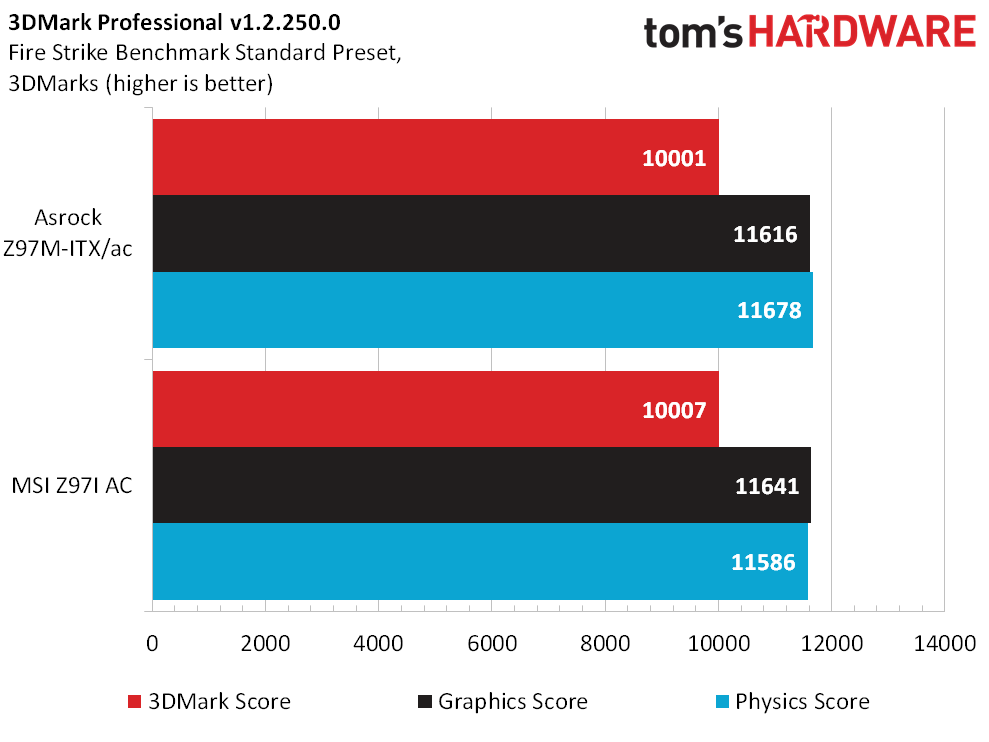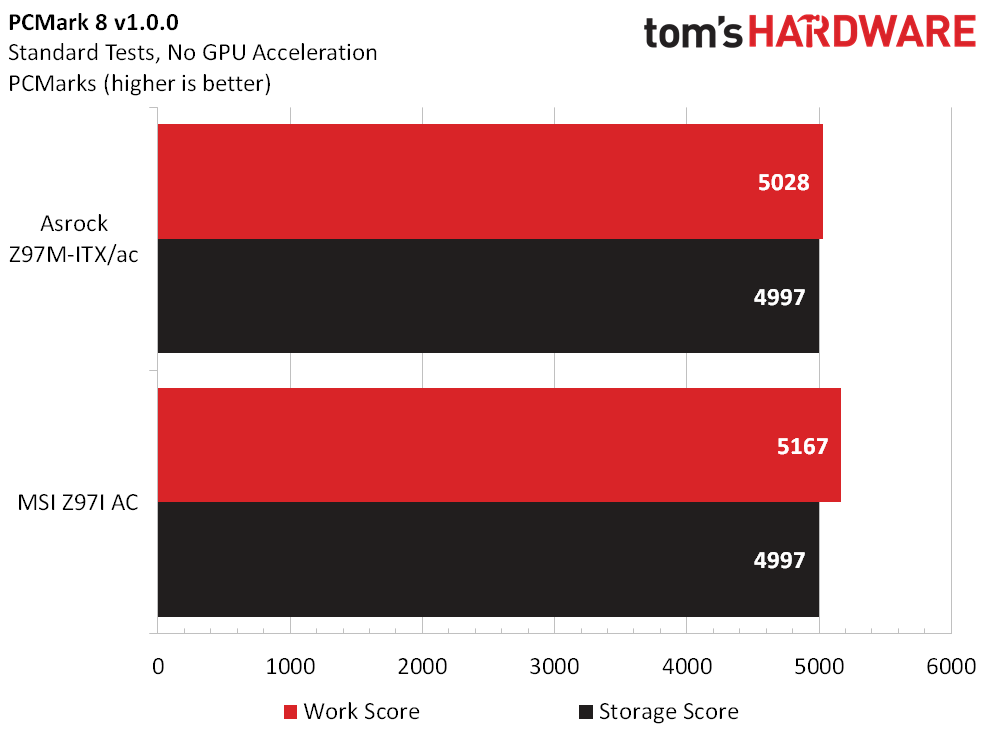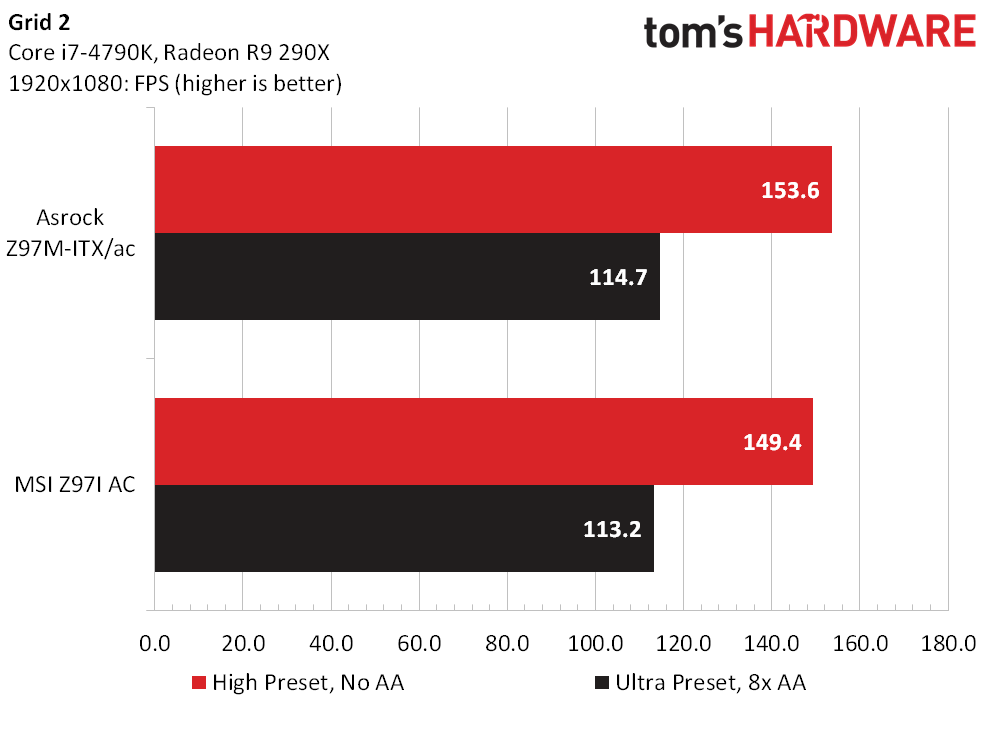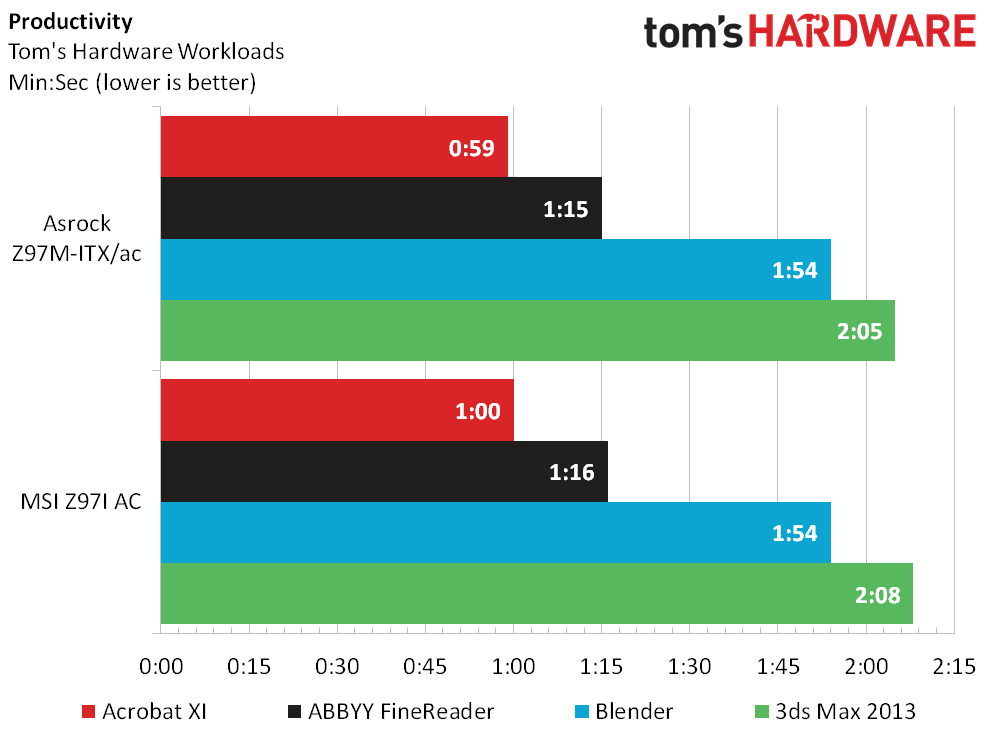ASRock Z97M-ITX/ac Versus MSI Z97I AC
Why you can trust Tom's Hardware
Benchmarks, Power, Efficiency And Overclocking
Because we test with Intel’s default CPU multiplier and power settings (disabling any Turbo Boost multiplier enhancements), the only way for a motherboard to claim a major win is by covert overclocking, which we don’t endorse since we prefer to set our own overclocks. The only way for a motherboard to fall noticeably behind the pack is if something is misconfigured.
Synthetic Benchmarks
Investigating a covert overclock or configuration difference can be quite time consuming, so we’re happy to see ASRock’s Z97M-ITX/ac and MSI’s Z97I AC nearly tied in 3DMark, PCMark and SiSoftware’s Sandra.







The only way to game our system a little without cheating is to tighten secondary and tertiary memory timings, which often has a negative impact on stability and a positive impact on both memory bandwidth and Sandra's Cryptography module. With no major differences found between these two motherboards, we don’t need any long-winded analysis.
Gaming Benchmarks
ASRock's Z97M-ITX/ac takes small leads across our gaming benchmarks, which doesn’t make sense when the graphics card remains consistent across platforms. Could this be due to software overhead? Disabled power-saving modes? Overclocking?




After checking to make sure that the CPU was indeed running at 4.2 to 4.4GHz (rather than locked at 4.4GHz through a motherboard-imposed setting), I decided to see if the power numbers showed anything. But first, the rest of the benchmarks!
Non-Gaming Applications
ASRock’s Z97M-ITX/ac leads by one second in about one-third of the timed benchmarks. We normally discount leads that small due to rounding up or down, but this many leads pique our curiosity.




Will the power numbers reveal anything?
Get Tom's Hardware's best news and in-depth reviews, straight to your inbox.
Power, Heat And Efficiency
Rather than indicating any cheating by ASRock, the power consumption numbers appear to show MSI’s Z97I AC setting power limits. Those kind of restrictions would also prevent the CPU from maintaining 4.2GHz under extra-heavy four-core loads, such as the Prime95 AVX test shown.




The math for these power limits actually works in MSI’s favor when it comes to efficiency, as the Z97I AC consumes 3.6% less power while generating 0.3% lower performance than the average of both boards. That’s a 3.4% efficiency gain over the average, and a more noteworthy 6.8% gain over the Z97M-ITX/ac it was competing against.
Overclocking
The Z97I AC isn't only more efficient. It also has a far cooler transistor group on its power regulator thanks to the inclusion of a small heat sink. This allows it to sustain slightly higher voltage levels, which in turn allow better overclocking.
Neither of the boards are able to reach the 4.6GHz expected of top samples because neither one could output enough current to support our 1.28V limit. At least MSI’s Z97I AC is able to support our processor’s two-thread-rated 4.4GHz with four or more threads active. That’s essentially what “Enhanced” turbo ratios are, and lots of non-overclockers enable them.
Current page: Benchmarks, Power, Efficiency And Overclocking
Prev Page Z97I AC Overclocking Software And Firmware Next Page Conclusion-
i7Baby 4K on integrated graphics?Reply
I think I'd prefer to use a very heavy graphics card.
Would it be a better deal to get a mitx mobo and add a pcie wifi card yourself? -
Luay Well, the reason WI-FI on mitx doesn't matter is because a simple USB WI-FI dongle will do the trick. Arguably, sound chips don't matter either becasue a USB headsets, or even better, HDMI from the video card through an AV receiver will also free up a motherboard's budget for the more important features we want.Reply
What's unforgivable in those two models is the lack of an M.2 slot. -
i7Baby Dongles don't work as well as pcie wifi cards mainly because dongles don't have good antennae.Reply
I don't think M.2 is worth it yet. The SSDs aren't any faster than sata SSDs - so far any way. -
Crashman Reply
Don't worry about 4k, think about QHD (2560x1440), particularly in work environments such as displaying large spreadsheets. People say the previous-generation HDMI and single-link DVI is limited to 1080p, but I think that's because they forget about the 1920x1200 option.15721416 said:4K on integrated graphics?
I think I'd prefer to use a very heavy graphics card.
Would it be a better deal to get a mitx mobo and add a pcie wifi card yourself?
The problem is that the ASRock board doesn't allow ANY resolution above 1920x1200, including the ever-present QHD.
The solution is that the MSI board allows EVERY resolution up to 4k, including the ever-present QHD.
I hope when I phrase it like that, you'll understand why 4k isn't the issue: It's the "up to 4k" part--those in-between settings like 2560x1440--that matter enough in typical integrated graphics markets to make this an important feature. -
dvanburen This Asrock board doesn't make a sensible purchase. Asrock offers a much nicer version (Z97E-ITX/ac) with a 6-phase power controller, Display Port, Intel LAN, VRM Heatsink, better audio and more. It's usually about $117 AR in the US, only a $15 premium over the reviewed Z97M-ITX/ac.Reply
Asrock also offers the H97M-ITX/ac, which is virtually identical to the reviewed Z97M-ITX/ac other than the chipset. Seriously, it's the same PCB. It's also $19 less expensive. I doubt that anyone is going to buy the Z97M-ITX/ac to overclock, so what's the point of choosing Z97 over H97? Oh, the H97M-ITX/ac can overclock too. So again, why does the Z97M-ITX/ac even exist?
TL,DR: Save your money and get the H97M-ITX/ac if you want a decent HTPC/NAS/Whatever. Buy the Z97E-ITX/ac if you want more features and better OC potential. Skip the Z97M-ITX/ac. -
logainofhades I wonder why Asrock sent there inferior board? Maybe someone at Asrock goofed. The Z97E-ITX/ac is definitely a far better board and includes an M.2 slot. Also the other companies that declined to offer a review sample, makes me feel they didn't see their product as good enough to compete. I shall avoid their ITX boards, in the future.Reply -
Onus Perhaps other mITX offerings will make an appearance soon...Reply
(If you don't care about overclocking, the H97M-ITXa/c is indeed a nice board)
Reviews are sometimes centered around a particular price point, which may be why the more premium products aren't shown here.
I just built Minion using a Maximus VII Impact. The only thing I wish it had, and this is minor, is a second USB2.0 header so I can use an existing card reader with it. I'll just buy an external USB3.0 card reader instead. -
logainofhades Their price is similar enough, that I don't see the point of the Z97 board we were given, vs the one we really wanted to see.Reply
PCPartPicker part list / Price breakdown by merchant
Motherboard: MSI Z97I AC Mini ITX LGA1150 Motherboard ($122.99 @ SuperBiiz)
Total: $122.99
Prices include shipping, taxes, and discounts when availableGenerated by PCPartPicker 2015-04-21 16:27 EDT-0400
PCPartPicker part list / Price breakdown by merchant
Motherboard: ASRock Z97E-ITX/ac Mini ITX LGA1150 Motherboard ($129.99 @ SuperBiiz)
Total: $129.99
Prices include shipping, taxes, and discounts when availableGenerated by PCPartPicker 2015-04-21 16:27 EDT-0400
PCPartPicker part list / Price breakdown by merchant
Motherboard: ASRock Z97M-ITX/AC Mini ITX LGA1150 Motherboard ($117.99 @ SuperBiiz)
Total: $117.99
Prices include shipping, taxes, and discounts when availableGenerated by PCPartPicker 2015-04-21 16:28 EDT-0400


